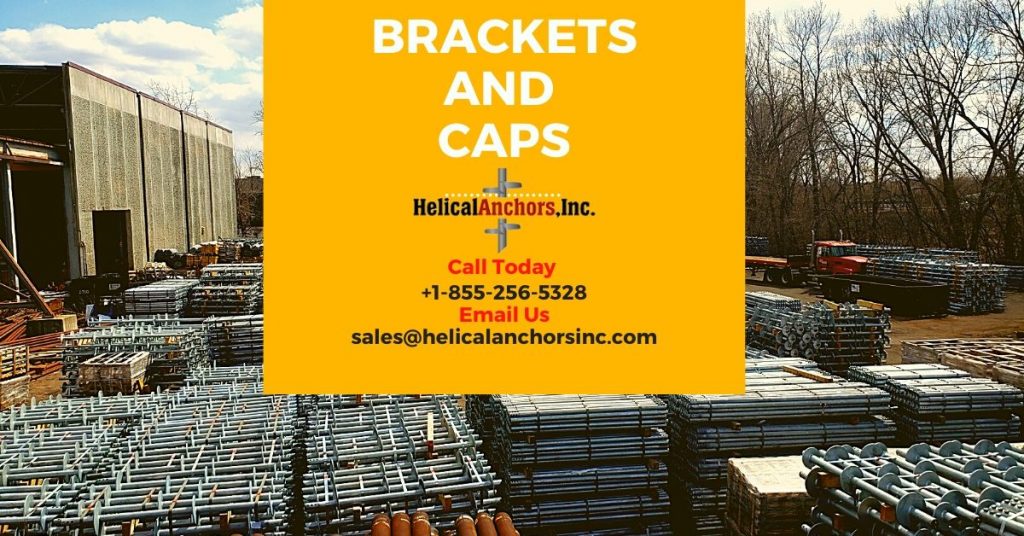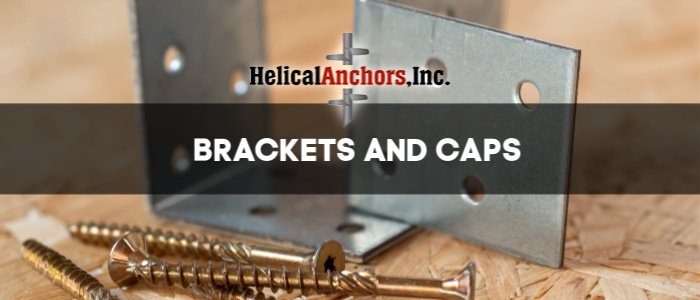Helical Anchors Inc. has all the necessary machines to make any type of accessory you need for your job. Below are some of our standard accessories that commonly used in the foundation industry.

Helical Anchors Inc makes a wide variety of caps and brackets. Every project is different so having flexibility and creativity is important when needing to service our customers.
We inventory common sizes for quick shipments but also have the ability to create and design specific pier brackets to fit any project needs.
Most of the time we inventory something that will work or have something in stock that we can modify to make the job run smoothly. Caps and Brackets are designed to transfer the load of the structure to the helical pile bracket.
For new construction projects, this is typically done by a cap. All projects are different but typically the foundation is dug out, the helical piles are installed to the correct requirements than the caps are placed on the
exposed helical pile. Once inspected and cleared the concrete or foundation system can be adjoined to the helical cap.
Common sizes are 6” x 6”, 8” x 8” or 10” x 10” and come in many different thicknesses. As mentioned as loads increase or decrease we can adjust the size of the cap. These caps come in three finishes; non- galvanized, galvanized, and spray galvanized.
STANDARD BRACKET
For stabilizing/lifting repairs of existing foundations. Anchor bolts hold bracket to footing. Load is then transferred to anchor.
HEAVY-DUTY BRACKET
Used for commercial buildings and industrial size loads.
LIGHT DUTY BRACKET
Used for a variety of applications for lighter structures.
HELICAL MOORING CAP
Attached to helicals for moorings and float docks.
LIFT BRACKET
For stabilizing / Lifting repairs of existing foundations. Anchor bolts hold bracket to footing. Load is then transferred to push pier that is
end bearing.
NEW CONSTRUCTION CAP
Place on foundation anchors for support of new structures. Tied to reinforcing bars prior to concrete being poured. Available in 6″, 8″, 10″, and 12″ square.
TIE BACK PACKAGE
Includes coupler, screw tightening system and wall plate.
BEAM SUPPORT BRACKET
Available in multiple sizes to accommodate beams of boardwalks, walkways, manufactured homes, etc.
FLOOR SLAB SUPPORT SYSTEM
System includes coupler, thread bar, and support plate.
QUICK CLIP
Includes coupler, screw tightening system and wall plate.
Under-footing 2-piece Pier Bracket
The pier bracket is connected temporarily to a drive stand or other suitable assembly that can support it during mounting to the concrete footing. The pier bracket is positioned underneath the foundation footing with its bearing plate under the bottom of the concrete footing. A hydraulic ram is then used to bring the bracket plate into bearing with the footing. A careful inspection should be made, making sure the face plates have continuous bearing across the entire piece. If the pier bracket does not fit properly pressure bearing grout must be applied to fill gaps. The pier bracket is then bolted to the footing with 1/2” diameter x 5-1/2” long anchor bolts to secure it in position. Vertical alignment should be verified to ensure the drive stand assembly frame is plumb prior to driving each pier section.
2-Piece Plate Pier Bracket
If the footing extends too far beyond the footing bracket mounting surface, it will have to be notched or cored through for the pier to pass through. Align the bracket centerline directly with the hole through the footing and carefully mark the locations of the anchor bolts on the mounting face of the structure. When a spread footing is not present a bolt template is used to locate and mark the anchor bolts where designed. Drill the mounting holes and insert the 3/4” diameter x 7-1/2” long anchor bolts where marked. These bolts go in the top four holes and should have a minimum embedment of 4-3/4”. The longer 3/4” diameter x 10” long bolts are placed in the four lower holes. The pier post brackets are positioned and fastened with the washers and nuts provided with the anchor bolts. Carefully check for continuous bearing along the bracket plates and if necessary apply pressure grout where needed. Vertical alignment is inspected to ensure the pier bracket will be plumb.
Driving Pier Sections
Position the lead section into the drive stand with the friction reduction collar facing downward and drive it into the soil using the hydraulic drive cylinder assembly. Put together the next section at the top of the pier section and continue driving additional pier sections until the minimum required length and push pressure are reached. Record the resistance encountered during driving of each pier section. This is typically done just before shutting off the valve to add another pier section. The resistance encountered at the end of driving the final pier section is the ultimate plunging capacity of the pier.
Note: Ensure the pier bracket is secured during the installation of each pier section.
Cutting Final Pier Section
The final section installed may need to be cut to proper length. The length to be cut varies depending on the required lift. Cut the section so that after the lift is complete the top of the pier cap will be about 1/4″ below the bottom of the lock off pins. Cut the final section to length carefully ensuring a 90° angle with the pipe axis. If the pier settles during the lift the top of the pier cap will end up more than 1/4″ below the bottom of the lock off pins. Shims are used to fill the gap up to a maximum of 1″ total accumulated shim height. Otherwise a new, longer final pier section must be cut so that the total shim height is held to 1″ or less.
Transferring Loads to Piers
The pier cap is installed on top of the last pier section. The structural loads are transferred to each pier by using a 25-50 ton hydraulic ram between each pier cap and a lift head mounted to the bracket using the same holes that were used for the drive stand. Several rams are actuated simultaneously through the use of hydraulic manifold(s) to raise the structure to the desired elevation. The process should be carefully monitored to ensure the structure is lifted properly and no footing cracks or movement in any direction occur. The flow to each ram is turned off when the desired elevation is reached at that location and the shut-off pressure is recorded. When all piers have been shut off at their proper elevations they are locked off mechanically using the lock-off pins and shims provided with the brackets. The hydraulic lifting jacks can then be de-pressurized and removed along with the lifting heads and their associated mounting pins. First reduce the overall system pressure to below the lowest individual pier shut-off pressure using the valve at the pump. Re-close the pump valve and begin de-pressurizing the individual piers, beginning with those that were shut off at the lowest pressure and proceeding in order of increasing shut-off pressure. Remove each jack after it is depressurized. Each time a pier valve is opened the pressure in the remaining system will increase. If the lowest-to-highest shut-off pressure sequence is followed, the system pressure should always be lower than the next shut-off pressure. If for any reason the lowest-to-highest shut-off pressure sequence is not followed, be sure to adjust system pressure with the pump valve as necessary to ensure the system pressure is lower than the shut-off pressure before opening any individual pier valve.
Note: Do not use any damaged or leaking hoses or hydraulic equipment. After completion of lift restoration, grout must be applied to the voids created between the foundation and underlying soil.
Clean Up
After all, piers are mechanically locked off and the lifting heads and hydraulic lifting system are removed, backfill the excavations with the excavated soil. Place the soil in 6 to 8 inch thick layers and thoroughly tamp each layer to obtain maximum density before adding the next layer. Ensure the surface all along the foundation is sloped downward away from the structure for at least 10 feet measured perpendicular to the foundation. The drop must always be at least 2.4 inches vertical over the first ten feet horizontal and typically should be at least 6 inches over that distance. If this grading cannot be accomplished or would cause drainage across property lines in excess of that which existed before the grading, an approved alternative method of diverting water away from the foundation must be provided. Dispose of all construction waste in a safe and legal manner.


